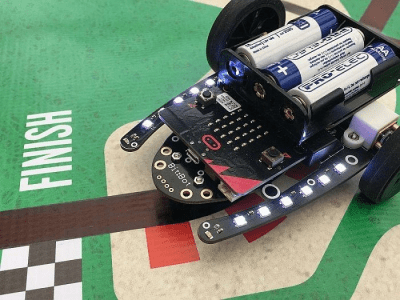There’s a new development board in town from Adafruit, and it’s called the CLUE. This tiny board can be programmed in Arduino or CircuitPython, and it is absolutely stuffed with sensors and functionality, including Bluetooth. It’s essentially a BBC Micro:bit with more sensors, a screen, and a much beefier processor. Sound interesting? Let’s get out the magnifying glass and take a look, shall we?
(Editor’s note: Adafruit ran out of the first alpha run of the hardware. While we didn’t run into any bugs, the next versions will presumably have even fewer, but will also cost $40 instead of $30. That said, they’re giving out 3,000 of them to attendants of PyCon in April, so you might also get your hands on one that way.)
First and foremost, there’s the form factor — if that bottom edge looks familiar, that’s because the CLUE is designed to work with micro:bit robot kits and anything else with that edge connector, like the CRICKIT for micro:bit, or the Bit:Bot from Seeed Studios. This is big news for the micro:bit ecosystem, and not just because the CLUE brings tons of sensors and a screen to the scene, although a 1.3″ screen at 240×240 resolution is nothing to sneeze at.
The main brain is a Nordic nRF52840, so you can pair it to your phone and stream your collected data. Or, use it to get two CLUE boards talking to each other. This is a major upgrade from the micro:bit’s nRF51822 — the CLUE is four times faster, has four times the flash memory, and has sixteen times as much RAM. We hope someone can find a way to make them into short-range messaging machines with Q10 keyboards.
Sensors Aplenty
The name CLUE is apt, because his board is all about discovery. Interested in recreating the falling eggs-periment, minus the eggs? Cradle your CLUE in bubble wrap and marshmallows and let the 9-DoF accelerometer/gyroscope/magnetometer get you all the data on its way down. This thing has a ton of environmental sensors too, like humidity, temperature, barometric pressure, and even altitude that will make it easy to prototype that weather station you’ve been meaning to build.
If you’ve been dying to get into portable game programming, the CLUE could be your board. Just think about all the different environment-based game mechanics you could use. There are also proximity, light, and gesture sensors, a speaker, and a MEMS microphone. Those two white LEDs by the USB port can do color sensing, which you could use to make a cool game for kids who are learning how to differentiate between colors.
If that isn’t enough sensors for you, there’s a STEMMA/Qwiic port that can also take Grove connector sensors with an adapter cable. Right now they’re working on a library to make it easy to access all …read more
Source:: Hackaday

